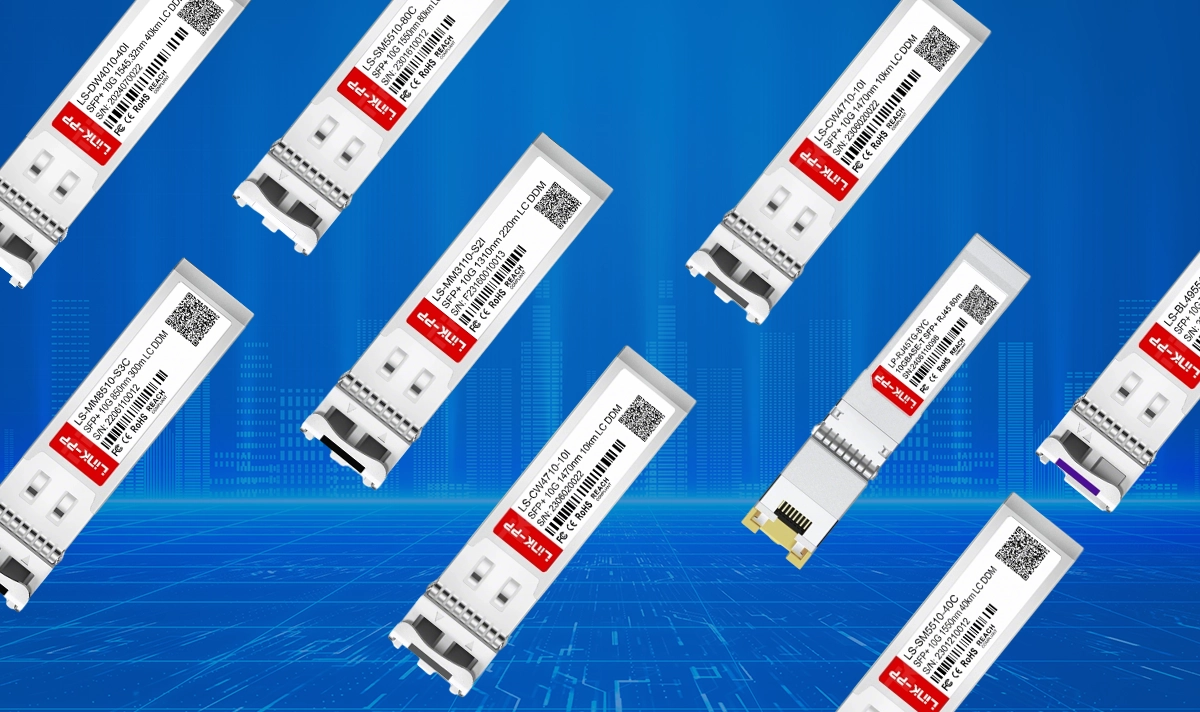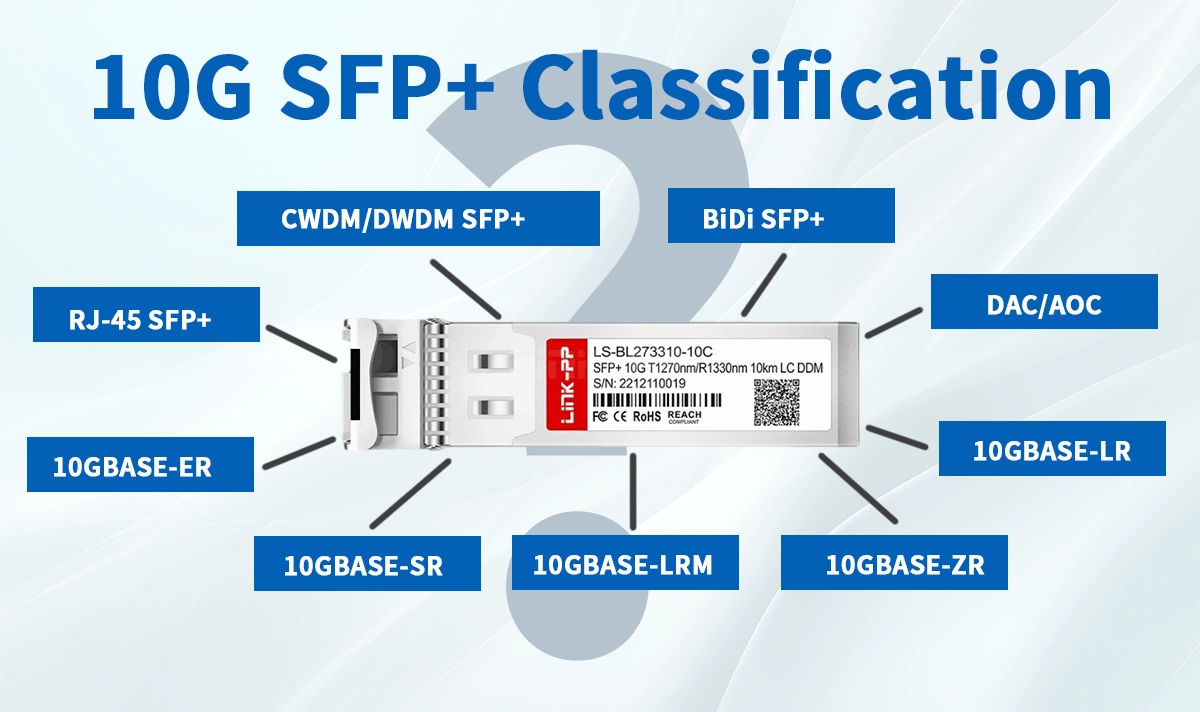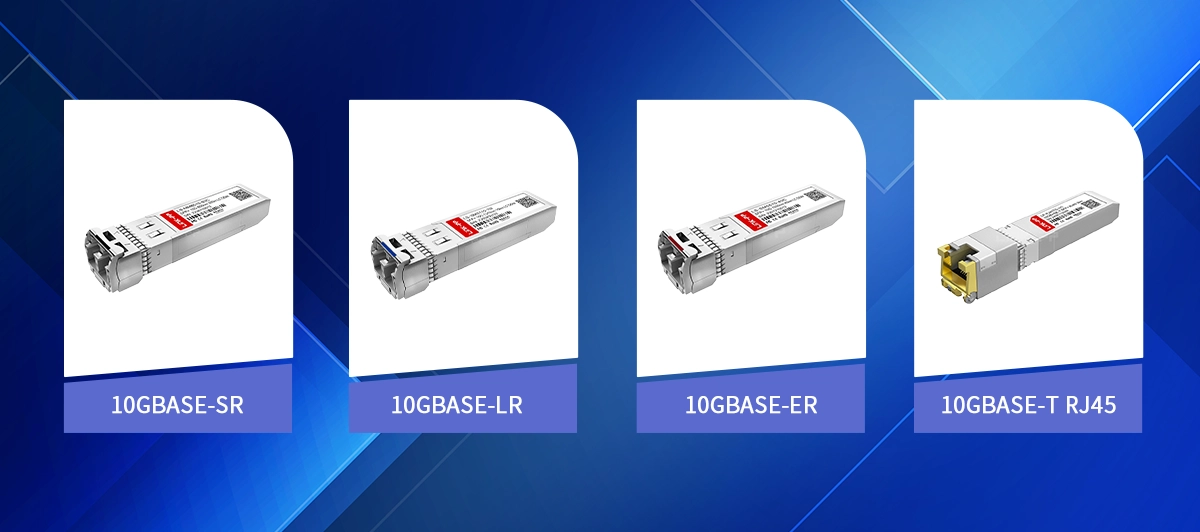
1. Introduction: What Makes 10G SFP+ Unique
10G SFP+ (Small Form-factor Pluggable Plus) is an enhanced optical transceiver supporting data rates up to 10 Gbps while maintaining the compact SFP form factor. It is hot-pluggable and ideal for high-density switches and routers, making it a standard for data centers and enterprise networks.
Proper classification helps network engineers select the correct module for each application, saving costs and ensuring compatibility.
2. Main Classification Dimensions
2.1 By Medium & Connector Interface
Optical fiber (LC duplex): Supports both multimode (MMF) and single-mode fiber (SMF).
Copper (RJ‑45): 10GBASE-T over Cat6a/7 cables, up to 80 m.
Direct‑Attach Copper (DAC) & Active Optical Cable (AOC): Short-range cables that plug directly into ports, ideal for cost-effective intra-rack links.
2.2 By Reach & Fiber Type
10GBASE-SR:
OM3 fiber: up to 300 m
OM4 fiber: up to 400 m
(Uses 850 nm VCSEL lasers; widely deployed in data centers for short-range links)
10GBASE-LRM:
OM1 fiber: up to 220 m
OM2 fiber: up to 300 m
(Operates at 1310 nm; suitable for legacy fiber upgrades in older infrastructure)
10GBASE-LR: up to 10 km at 1310 nm using DFB lasers
10GBASE-ER: up to 40 km at 1550 nm using EML
10GBASE-ZR: up to 80 km at 1550 nm for long-haul connections
2.3 By Wavelength Multiplexing
CWDM SFP+: Coarse WDM, medium distance, cost-effective wavelength expansion.
DWDM SFP+: Dense WDM, supports high-channel-count networks.
BiDi SFP+: Bidirectional transmission on a single fiber using two wavelengths (e.g., 1490/1550 nm).
2.4 By Rate Capability
Single-rate: Supports only 10 Gbps.
Dual-rate: Supports both 1 Gbps and 10 Gbps, offering network flexibility during upgrades.
2.5 By Electrical Design
Limiting modules: Include signal amplifiers for reshaping weak signals.
Linear modules: No amplifier; rely on host system for signal integrity.

3. Practical Classification Table
Category | Mode | Distance | Wavelength | Use Case |
|---|---|---|---|---|
10GBASE-SR | MMF (OM3/OM4) | 300 m / 400 m | 850 nm | Short-range data center links |
10GBASE-LRM | MMF (OM1/OM2) | 220 m / 300 m | 1310 nm | Legacy fiber upgrades |
10GBASE-LR | SMF | ≤10 km | 1310 nm | Campus backbone & metro links |
10GBASE-ER | SMF | ≤40 km | 1550 nm | Metro/data center interconnects |
10GBASE-ZR | SMF | ≤80 km | 1550 nm | Long-haul backbone links |
CWDM/DWDM SFP+ | SMF | Varies | 1270–1610 nm | WDM & DWDM network expansion |
BiDi SFP+ | SMF (single strand) | Varies | Dual λ | Single-fiber deployments |
RJ‑45 SFP+ | Copper | ≤30 m | – | Copper network upgrades |
DAC/AOC | Copper / MMF | DAC ≤7 m, AOC ≤100 m | – | Direct switch-to-switch links |
4. Choosing the Right 10G SFP+ Module
Define link distance and fiber type:
Up to 300 m? → SR on OM3/OM4.
1–10 km? → LR on SMF.
10–40 km? → ER.
40–80 km? → ZR or WDM.
Connector type:
LC duplex for fiber; RJ‑45 for copper 10GBASE-T.
DAC/AOC for short-range direct connections.
Ensure compatibility:
Both ends must match the module type (SR ↔ SR, LR ↔ LR). Use MSA-compliant modules to avoid vendor lock-in.Decide single- vs dual-rate:
Dual-rate modules support phased migration between 1G and 10G.Monitor with DOM/DDM:
Digital diagnostics monitor temperature, voltage, and optical power in real time.
5. Why Choose LINK‑PP 10G SFP+ Modules?

LINK‑PP offers a full range of 10G SFP+ modules: SR, LRM, LR, ER, ZR, CWDM, DWDM, BiDi, copper (RJ45), DAC, and AOC. Key advantages:
MSA-compliant: Seamless compatibility with OEM equipment.
Built-in DOM/DDM: Real-time monitoring for reliability.
Cost-efficient: High performance at competitive pricing.
Technical support & warranty: Direct from LINK‑PP official store.
6. Conclusion
Classifying 10G SFP+ transceivers requires considering:
Transmission medium & connector
Reach & fiber type (MMF OM1–OM4, SMF)
Wavelength multiplexing (CWDM/DWDM/BiDi)
Electrical and rate design
Selecting the correct module—SR, LRM, LR, ER, ZR, copper, or WDM—ensures optimal performance, compatibility, and cost efficiency. LINK‑PP’s 10G SFP+ lineup spans all categories, providing flexibility without compromising reliability.




